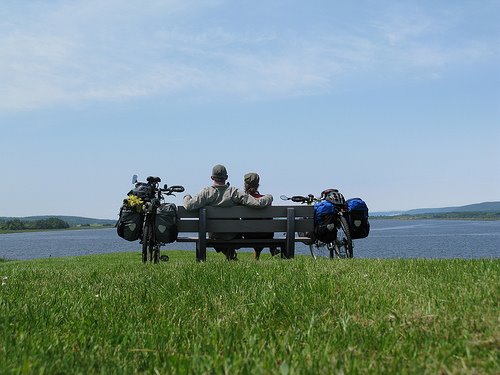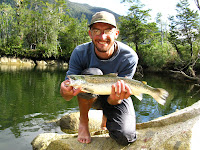After a day longer than I'd hoped in Coyhaique, watching an endless drip from the sky drowning my hopes of progress, I woke to parting skies, bone-chilling cold and a fresh layer of snow on the surrounding peaks. I left town smothered in down and was soon drenched in sweat, climbing the small sprints only to have it freeze solid to my body as I barreled down the backsides. Despite the added weight on my bike, thanks to a couple of over-zealous shopping excursions anticipating lonely roads ahead, I found myself screaming along with the help of a gale-force tailwind from the north. My grins of good fortune were perhaps a tad premature though as, 60km into my day, I finally stopped to inspect an odd knocking sensation that had finally achieved this-isn't-going-away-on-it's-own status coming from my crank with each revolution. Thinking it was a pesky pedal bearing that had been dogging me for several months, I went to give it the jiggle I usually do that makes it go away for another week or so (out of sound, out of mind, right?). As I grasped my pedal, the usual firmness of my well tuned machine played sloppily in my hand. Another tug and I felt my whole crank, indeed my immediate future on the road, wobble like a drunken man on a unicycle. With a terminally ill bottom bracket, my options were suddenly limited. I pondered this for a moment, trying to imagine exactly how I was going to employ the use of my rations of duct tape and baling wire to solve this problem and suddenly realized that, in short, I was screwed. Return from whence I came (headfirst into the hurricane force winds I had just been enjoying) or continue on, take the shortcut across Lago General Carerra and hope for some miracle in either Chile Chico or Los Antiguos, the last two towns before beginning the long stretch into nowhere on Ruta 40.
I chose option two and, after a long night enduring winds that I have only heard tell of in movies like Twister or The Wizard of Oz, caught the morning ferry to Chile Chico. My enthusiasm for this grand lake I had been looking forward to circling for so long was tempered by the fact that I was missing a fantastic ride around the lake by taking the ferry across it and also by the realization that I would be a fool to continue on in the face of the pending failure of my bottom bracket. Upon reaching the other side, I paused in the small, cozy town of Chile Chico to ascertain the likelihood of finding a modern-day splined bottom bracket in a small touristy border town. After visiting most of the twelve or so buildings that make up the town, it became apparent that there was none to be had as the most modern bike in town looked to be about as old as me.
I again reflected on my journey, where I was and where I wanted to be...two very different places. The glory road in soutern Chile is the Careterra Austral, the best part being from Coyhaique south bisecting glacially carved valleys and passing through impossibly remote countryside. Due to extreme weather conditions during most of the year, critical ferries connecting the route run only in the peak months of December through March, thus making the route virtually impassable the rest of the year (this theory has recently been debunked by our friend Sarah and her compadre and will again be put to test by another road brother in the coming months). As a result, the adventurous off-season cyclist is left with no option but to endure a week or so of some of the worst conditions a biker can imagine on the Argentina side following Ruta 40; horrible roads, extreme distances between food and water supplies and unfathomably strong cross winds that often make cycling impossible (let alone setting up a tent, using a stove, etc.).
A long night in Los Antiguos left me more sure than ever that it was time to pack up, swallow my pride and cut my losses. This trip has never been about the destination, but about the journey; the getting there, anywhere; the adventure of never knowing where we were going to end up when the wheels stopped rolling. I felt that, for the moment at least, the wheels had stopped. The weather was tickling me with the promise of much colder days to come, my bike was hopelessly ill and I had lost some crucial motivation. I vowed to return as soon as the weather and Kirsten's schedule allows, hopped on the once weekly bus out of town and headed north.
So, that's where the story ends for now. Nearly 11,000km, 317 days and a world away from where we started, I was back home. Stay tuned for more tales from the road when we return in mid December.


















 Although Bolivia was a quick passing in our Latin America riding adventures, it was spectacular at times, frustrating at others and deserves a closer look into the inner workings of its day to day business transactions. Outside of the cities, the scenery was breathtaking and suprisingly free of the litter that pervades LA. We rode through landscapes that reminded us of the desolation of Nevada, the canyons of Arizona and the red rock formations of Utah. Along this stretch of deserted road to the Salar Uyuni in SW Bolivia, only three cars passed in our direction in three entire days. The road was very challenging as we pushed our bikes through sand, shook and girated through washboard and screamed (Kirsten) obscenities as we humped our bikes back and forth from the horrible main road to the nearly as horrible frontage road.
Although Bolivia was a quick passing in our Latin America riding adventures, it was spectacular at times, frustrating at others and deserves a closer look into the inner workings of its day to day business transactions. Outside of the cities, the scenery was breathtaking and suprisingly free of the litter that pervades LA. We rode through landscapes that reminded us of the desolation of Nevada, the canyons of Arizona and the red rock formations of Utah. Along this stretch of deserted road to the Salar Uyuni in SW Bolivia, only three cars passed in our direction in three entire days. The road was very challenging as we pushed our bikes through sand, shook and girated through washboard and screamed (Kirsten) obscenities as we humped our bikes back and forth from the horrible main road to the nearly as horrible frontage road.